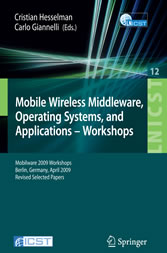Suchen und Finden
Mehr zum Inhalt

Mobile Wireless Middleware, Operating Systems and Applications - Workshops - Mobilware 2009 Workshops, Berlin, Germany, April 28-29, 2009, Revised Selected Papers
Preface
5
Organization
7
Table of Contents
10
BMMP Workshop
10
“Just Another Distribution Channel?”
12
Introduction
12
The Development of the Industries
13
Analysis of Technological and Industry Developments
16
Discussion: Position of a Mobile Operator in the Content Industry
19
In Conclusion
22
References
23
Adding Value to the Network: Exploring the Software as a Service and Platform as a Service Models for Mobile Operators
24
Introduction
24
Software as a Service
25
Revenue Models
26
Benefits and Risks
26
Platform as a Service
27
Revenue Models
28
Benefits and Risks
28
Summary of Benefits and Risks
30
Analysis of Emerging Experiences of Mobile Operators’ Service Platforms
31
Conclusion
32
References
33
Business Model Evaluation for an Advanced Multimedia Service Portfolio
34
Introduction
34
Typical Business Scenes
35
Technical Analysis of the Service Portfolio Provision
36
System Architecture Design
36
System Architecture Approximation
37
Modelling the Collaborative Service Provision
39
Numerical Implementation
42
Conclusions and Future Work
43
References
43
Connecting Business Models with Service Platform Designs – Quantitative, Scenario-Based Framework
44
Introduction
44
Techno-Business Modeling Framework
45
Service Platform Approximate
46
Modeling Usage of Services and Enablers
47
Modeling Service Provision
49
Scenario-Based Analysis and Valuation
50
Practical Case – SPICE Mobile Service Platform
51
Conclusion
54
References
55
The Borders of Mobile Handset Ecosystems: Is Coopetition Inevitable?
56
Introduction
56
It’s All about Business Ecosystems
57
Is Exclusivity in Relationships Possible?
58
Methodological Approach
59
Findings
60
Conclusion
64
References
65
Trends in Mobile Application Development
66
Introduction
66
Current Practices
67
Development Tools
68
Portals
69
Platform Integration
69
Trends
70
Towards Portal Centralization
70
Towards Technological Openness
71
Towards Full Integration
71
Implications for Developers
72
Implications of Portal Centralization
73
Implications of Technological Openness
73
Implications of Platform Integration
73
Implication of the Platform Choice
74
Conclusion
74
References
75
WASP Workshop
10
A Middleware Architecture Supporting Native Mobile Agents for Wireless Sensor Networks
76
Introduction
76
System Architecture
77
Mobility Manager
77
Security Manager
78
Operation Manager
79
Evaluation
79
AvroraZ
79
Physical Scenario
79
Agents
80
Agent Middleware
80
Results
81
Significance and Discussion
82
Robustness and Self-management
82
Structure and Flexibility
82
Alternatives
82
Related Work
83
Stateless Interpreted
83
Stateless Native
84
Stateful Interpreted
84
Conclusion
84
References
85
Map-Based Compressive Sensing Model for Wireless Sensor Network Architecture, A Starting Point
86
Introduction
86
System Model
87
Compressive Sensing: Mathematical Basics and Applicability to WSN
87
Sparse and Compressible Signals
88
Incoherent Sparse Sampling and Recovery
89
CS Advantages and Its Application in WSN
90
CS-Oriented Map-Based (CSM) Architecture
90
Evaluation of CSM with an Exhaustive Algorithm
91
Related Work
93
Conclusion and Future Work
94
References
94
Mobility and Remote-Code Execution
96
Introduction
96
Abstraction, Model and Mechanism
97
The Remote-Code Execution Abstraction
99
Design Paradigms
99
Models of the Remote-Code Execution Abstraction
100
Discussion
104
From Models to RCE Mechanisms
104
Execution System
105
RCE Models Implementation
105
Conclusion
107
References
107
UCPA Workshop
10
A Component-Based Approach for Realizing User-Centric Adaptive Systems
109
Introduction
109
User-Centric Pervasive Adaptation
110
Realizing User-Centric Software
110
Example Scenario: Adaptive Interactive Installations
112
Related Work
114
Conclusion and Future Work
114
References
115
A Reflective Goal-Based System for Context-Aware Adaptation
116
Introduction
116
A Reflective User Goal-Based Context-Aware Framework
117
Contexts
117
Adaptation Layers
118
The Reflective Middleware
119
Application Trial and Discussion
120
Conclusion
121
References
121
Pervasive Adaptation in Car Crowds
122
Car Crowds as Socio-Technical Systems
122
Driver-Vehicle Co-Models
124
A Collective Driver-Vehicle Co-Model
126
Conclusions and Further Work
127
References
127
Developing User-Centric Applications with H-Omega
129
Introduction
129
Requirements and Background
130
Requirements for Successful Pervasive Computing
130
Service-Oriented Computing
131
H-Omega: An Application Server for Pervasive Applications
132
The Follow Media Application
133
Conclusion
134
References
134
Utilization Possibilities of Area Definition in User Space for User-Centric Pervasive-Adaptive Systems
135
Introduction
135
The PDPT Framework and PDPT Core
136
Predictive Data Push Technology
136
The PDPT Framework Design
137
PDPT Core – Static and Dynamic Area Definition
137
The PDPT Client Application and Testing Results
139
New Utilization Possibilities of Area Definition
140
Conclusions
141
References
141
Ubi-Islands Workshop
11
Architecture of a Personal Network Service Layer
142
Introduction
142
Architecture
143
Conclusions and Future Work
144
References
145
Connecting the Islands – Enabling Global Connectivity through Local Cooperation
146
Introduction
146
Cooperation
148
Network Coding
149
Challenges and Considerations
150
References
151
Mapping the Physical World into the VirtualWorld: A Com2monSense Approach
153
Introduction
153
Com2monSense
154
Implementation
155
Scenario: Smart Open Spaces
156
Conclusions
156
References
156
Ubiquitous Mobile Awareness from Sensor Networks
158
Introduction
158
Exchanging Sensor Information with 3GPP IMS
159
Ubiquitous Mobile Awareness Services
160
Conclusions
160
References
161
Author Index
162
Alle Preise verstehen sich inklusive der gesetzlichen MwSt.








